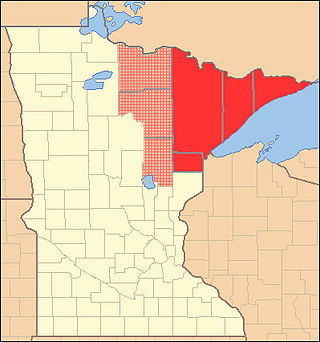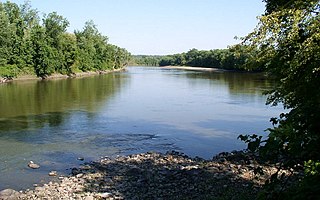Related Research Articles

In archaeological terminology, a projectile point is an object that was hafted to a weapon that was capable of being thrown or projected, such as a javelin, dart, or arrow. They are thus different from weapons presumed to have been kept in the hand, such as knives, spears, axes, hammers, and maces.

Clovis points are the characteristically fluted projectile points associated with the New World Clovis culture, a prehistoric Paleo-American culture. They are present in dense concentrations across much of North America and they are largely restricted to the north of South America. There are slight differences in points found in the Eastern United States bringing them to sometimes be called "Clovis-like". Clovis points date to the Early Paleoindian period, with all known points dating from roughly 13,400–12,700 years ago. As an example, Clovis remains at the Murry Springs Site date to around 12,900 calendar years ago. Clovis fluted points are named after the city of Clovis, New Mexico, where examples were first found in 1929 by Ridgely Whiteman.

An arrowhead or point is the usually sharpened and hardened tip of an arrow, which contributes a majority of the projectile mass and is responsible for impacting and penetrating a target, as well as to fulfill some special purposes such as signaling. '

Folsom points are projectile points associated with the Folsom tradition of North America. The style of tool-making was named after the Folsom site located in Folsom, New Mexico, where the first sample was found in 1908 by George McJunkin within the bone structure of an extinct bison, Bison antiquus, an animal hunted by the Folsom people. The Folsom point was identified as a unique style of projectile point in 1926. The Folsom point found in association with the extinct bison bones proved to the scientific community that humans had lived in the Americas thousands of years longer than many had previously believed.

The Folsom tradition is a Paleo-Indian archaeological culture that occupied much of central North America from c. 10800 BCE to c. 10200 BCE. The term was first used in 1927 by Jesse Dade Figgins, director of the Denver Museum of Nature and Science. The discovery by archaeologists of projectile points in association with the bones of extinct Bison antiquus, especially at the Folsom site near Folsom, New Mexico, established much greater antiquity for human residence in the Americas than the previous scholarly opinion that humans in the Americas dated back only 3,000 years. The findings at the Folsom site have been called the "discovery that changed American archaeology."

The Plano cultures is a name given by archaeologists to a group of disparate hunter-gatherer communities that occupied the Great Plains area of North America during the Paleo-Indian or Archaic period.

The Arrowhead Region is located in the northeastern part of the U.S. state of Minnesota, so called because of its pointed shape. The predominantly rural region encompasses 10,635.26 square miles (27,545.2 km2) of land area and includes Carlton, Cook, Lake and Saint Louis counties. Its population at the 2000 census was 248,425 residents. The region is loosely defined, and Aitkin, Itasca, and Koochiching counties are sometimes considered as part of the region, increasing the land area to 18,221.97 square miles (47,194.7 km2) and the population to 322,073 residents. Primary industries in the region include tourism and iron mining.
Oshara Tradition, the northern tradition of the Picosa culture, was a Southwestern Archaic tradition centered in the area now called New Mexico and Colorado. Cynthia Irwin-Williams developed the sequence of Archaic culture for Oshara during her work in the Arroyo Cuervo area of northwestern New Mexico. Irwin contends that the Ancestral Puebloans developed, at least in part, from the Oshara.
The old Cordilleran culture, also known as the Cascade phase, is an ancient culture of Native Americans that settled in the Pacific Northwestern region of North America that existed from 9000 or 10000 BC until about 5500 BC.
A Cascade point is a projectile point associated with the Cascade phase, an ancient culture of Native Americans that settled in the Pacific Northwest that existed from 9000 or 10000 BC until about 5500 BC.
The Phillips-Williams Fork Reservoir site (5GA1955) is a Paleoindian site located on the shore of the Williams Fork Reservoir, about 20 kilometers (12 mi) southeast of Kremmling at an elevation of 2400 m (7874 ft.) in Grand County, Colorado, near the center of Middle Park.
Eden Points are a form of chipped stone projectile points associated with a sub-group of the larger Plano culture. Sometimes also called Yuma points, the first Eden points were discovered in washouts in Yuma County, Colorado. They were first discovered in situ at an ancient buffalo kill site near Eden, Wyoming by Harold J. Cook in 1941. The site, named after discoverer O. M. Finley, eventually yielded 24 projectile points, including eight Eden points, eight Scottsbluff points and one complete Cody point, both other sub-groups within the Plano group. Eden points are believed to have been used between 10,000 and 6,000 years ago by paleo-indian hunters in the western plains.

Traverse des Sioux is a historic site in the U.S. state of Minnesota. Once part of a pre-industrial trade route, it is preserved to commemorate that route, a busy river crossing on it, and a nineteenth-century settlement, trading post, and mission at that crossing place. It was a transshipment point for pelts in fur trading days, and the namesake for an important United States treaty that forced the Dakota people to cede part of their homeland and opened up much of southern Minnesota to European-American settlement.

The Bare Island projectile point is a stone projectile point of prehistoric indigenous peoples of North America. It was named by Fred Kinsey in 1959 for examples recovered at the Kent-Halley site on Bare Island in Pennsylvania.
Dust Cave is a Paleoindian archaeology site located in northern Alabama. It is in the Highland Rim in the limestone bluffs that overlook Coffee Slough, a tributary of the Tennessee River. The site was occupied during the Pleistocene and early Holocene eras. 1LU496, another name for Dust Cave, was occupied seasonally for 7,000 years. The cave was discovered in 1984 by Dr. Richard Cobb and initially excavated in 1989 under Dr. Boyce Driskell from the University of Alabama.

In the classification of Archaeological cultures of North America, the term Plainview points refer to Paleoindian projectile points dated between 10,000 and 9,000 Before Present. The point was named in 1947 after the discovery of a large cache of unfluted, lanceolate spear tips with concave bases that were found in a Bison antiquus kill site along the Running Water Draw river, near the town of Plainview in Texas, United States. The point is found primarily throughout the South Plains, however, this range may sometimes be misidentified, as "Plainview" was previously used as a general term to describe unfluted lanceolate points throughout the entirety of the Plains, as well as the eastern Upper Mississippi Valley.
Franktown Cave is located 25 miles (40 km) south of Denver, Colorado on the north edge of the Palmer Divide. It is the largest rock shelter documented on the Palmer Divide, which contains artifacts from many prehistoric cultures. Prehistoric hunter-gatherers occupied Franktown Cave intermittently for 8,000 years beginning about 6400 BC The site held remarkable lithic and ceramic artifacts, but it is better known for its perishable artifacts, including animal hides, wood, fiber and corn. Material goods were produced for their comfort, task-simplification and religious celebration. There is evidence of the site being a campsite or dwelling as recently as AD 1725.
Sisyphus Shelter is an archaeological site that was uncovered in Colorado when the Colorado Department of Highways was working on I-70. The excavation of this site became a joint project between the Colorado Department of Highways and the Bureau of Land Management. Fieldwork on the site was completed in 1980. Archaeologists John Gooding and Wm. Lane Shields as well as many others completed the excavation and prepared a comprehensive site report. Over the course of the fieldwork on Sisyphus Shelter, twenty-six features of human origin were discovered as well as numerous stone artifacts and two perishable items. The artifacts appeared to be all Late Archaic in origin. Dating indicated a range of occupations from modern times to 4400 B.P. being the oldest sample. Gooding and Shields (1985) suggest that the occupations of the shelter were not consistent and affected by seasonal changes.
The Carlston Annis Shell Mound is a prominent archaeological site in the western part of the U.S. state of Kentucky. Located along the Green River in Butler County, this shell midden has been declared a historic site because of its archaeological value.
The Quad site is a series of Paleoindian sites and localities in Limestone County near Decatur, Alabama. It was first reported by Frank Soday in 1954, and later findings were also documented by James Cambron, David Hulse and Joe Wright and Cambron and Hulse. The Quad Locale can seldom be viewed at current lake levels, even during normal winter pool, due to extensive erosion, but is considered one of the most important and well known Paleoindian sites in the Southeastern United States.